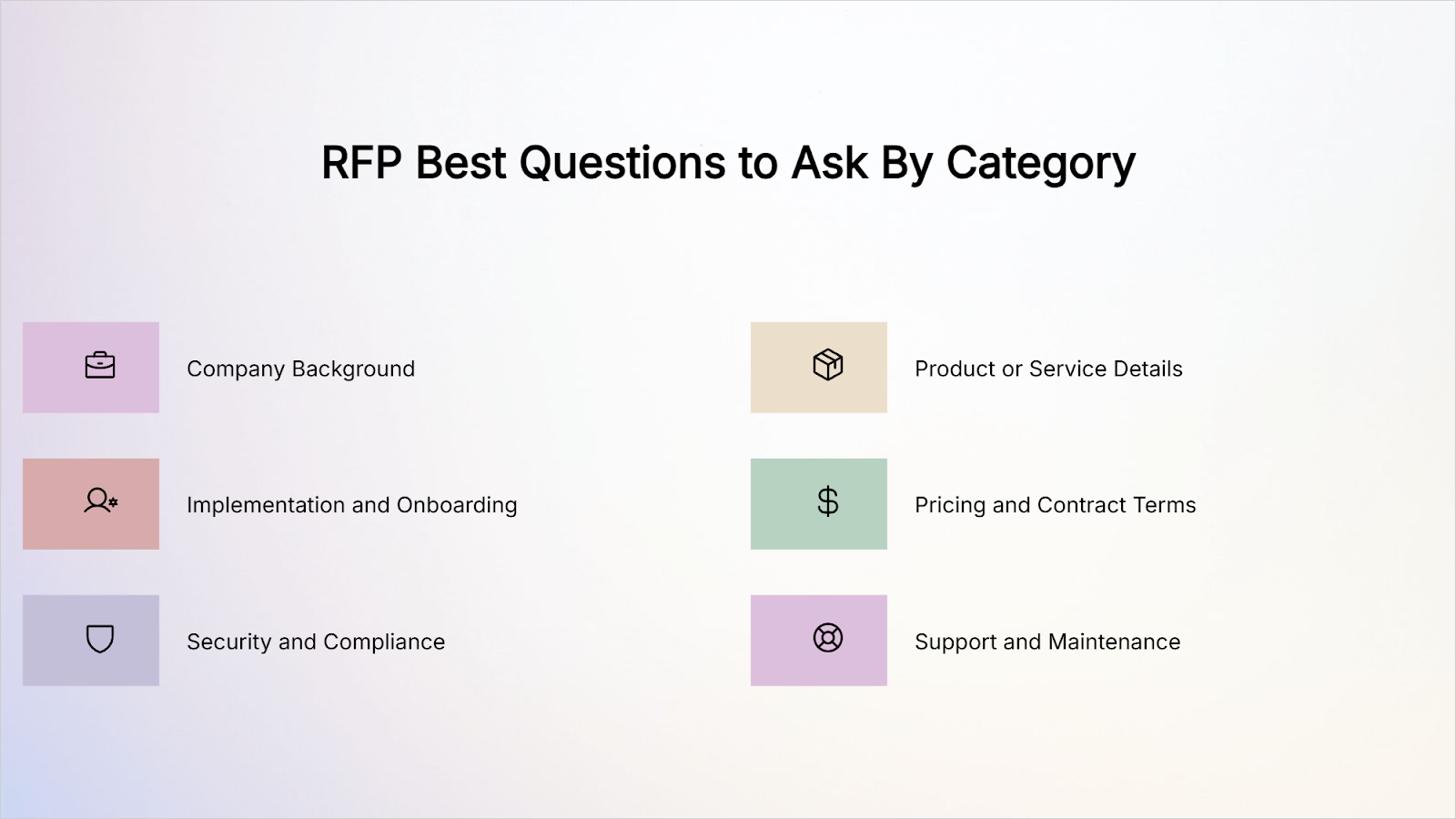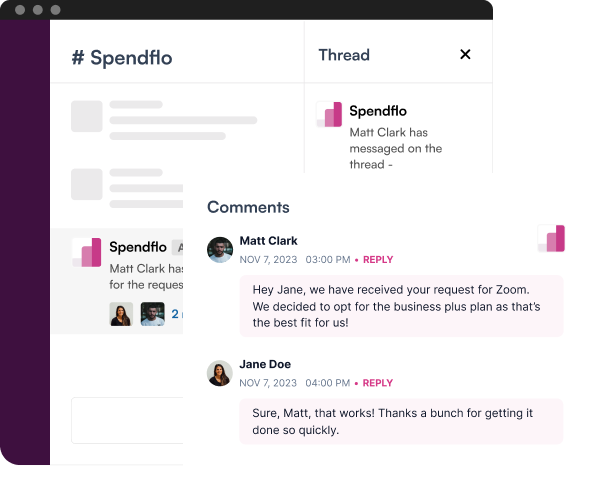

31 Request For Proposal (RFP) Questions to Ask Vendors
%20Questions%20to%20Ask%20Vendors.webp)
31 Request For Proposal (RFP) Questions to Ask Vendors
Discover 31 essential RFP questions to evaluate vendors effectively. Learn how to avoid common mistakes and streamline vendor selection using Spendflo.
%20Questions%20to%20Ask%20Vendors.webp)

According to a survey of more than 1,500 teams done by Loopio in partnership with Association of Proposal Management Professionals , the average win-rate for RFPs in the U.S. is 45 percent.
If you find yourself asking vendors the same general questions or receiving responses that leave you unsure about what you’re really signing up for, you’re definitely not alone. Having a clear list of smart questions helps you compare vendors more confidently and get better-matched answers.
What Is an RFP and Why It Matters
A Request for Proposal (RFP) is an official document used by organizations to invite vendors to submit offers for products or services. It outlines project objectives, technical details, timelines, and performance standards to ensure fair competition. A clear RFP saves time, filters unsuitable vendors, and helps select those offering the best value. In SaaS and procurement, well-structured RFPs enhance cost control, transparency, and risk management before contract signing.
RFP Best Questions to Ask Vendors By Category
The best RFPs go beyond pricing. They uncover whether a vendor truly meets your needs. Here’s a breakdown of 31 essential RFP questions to ask vendors, grouped by category.
1. Company Background
- What is the duration of your time of operation in your category/space?
- Which type of clients or industries do you serve mostly?
- What makes your solution unique to competitors?
- Which are the top three customers that you are dealing with at the moment and can you give references?
- Where are your headquarters and support departments based?
2. Product or Service Details
- Would you please describe your product or service in detail?
- What is the main aspect of your core offering?
- To what extent can your solution be made customizable to unique workflows?
- What are your integrations (ERP, CRM, procurement tools)?
- What are your product improvements or additions in your product roadmap?
3. Implementation and Onboarding
- What is the typical implementation timeline?
- What training or documentation do you provide for users?
- How do you manage data migration and integration?
- What level of support is available during rollout?
- What resources or roles do you require from our internal team?
4. Pricing and Contract Terms
- What is your pricing model (Subscription, license or use-based)?
- Does it have any setup fee, onboarding fee or any hidden fee?
- Standard term What a typical contract contains and flexibility of terms.
- Are you a multi-year or volume discount provider?
- What is your renewal policy and how do increases in price go?
5. Security and Compliance
- Which data protection standard(s) do you comply with (e.g. SOC 2, ISO 27001)?
- What is the way sensitive information is stored and encrypted?
- Do you endorse GDPR or regional compliance requirements?
- What do you do when there is a data or incident breach?
- Is it possible to update your recent security audit report or certifications?
6. Support and Maintenance
- What are your response time and support hours?
- What is the contact information of your support team (chat, email, phone)?
- How do you scale up critical issues?
- Do you offer a dedicated account manager?
- What is the frequency of system updates or patches?
- What is your measure and reporting of customer satisfaction?
These RFP questions to ask the vendor cover vendor reliability and technology fit to cost transparency and compliance. Tailor them to your organization’s size, industry, and risk tolerance.

Mistakes to Avoid in Your RFP Approach
Even experienced teams can face challenges in the RFP process. The slightest misstep can result in time wastage, vague vendor responses, or unsatisfactory contract issues. Below are common mistakes and how to prevent them.
1. Writing Vague Requirements
When the scope of the project is unclear, vendors are forced to make assumptions. This leads to irrelevant or incomplete vendor responses. Include detailed requirements like sample RFP questions, expected support model, and performance reporting metrics. Mention specifics such as disaster recovery, support teams, and security measures to ensure the vendor evaluations are accurate and consistent.
2. Prioritizing Price Over Fit
Selecting the lowest bid might look like a win but can lead to contract issues later. Vendors offering cheaper rates may compromise on customer support, fail to meet compliance like ISO 27001, or lack Vendor Stability. Focus instead on long-term value, market position, and their ability to handle Implementation & Support, content creation, or lead generation if relevant to your business.
3. Ignoring Scalability and Future Growth
The vendor that fits your current needs might not adapt to future market expansion. Always evaluate their delivery models, support response, and ability to manage contingent workforce or Temporary Workers efficiently. For global operations, consider factors like local taxes, benefits packages, independent contractor compliance, and adherence to regulations such as California’s AB5 Law.
4. Bypassing Internal Alignment
If procurement, finance, HR, and IT are not aligned, the Requests for Proposals process can stall. Before sending out the RFP, ensure all teams understand the evaluation process, supplier terms, and project goals. This helps in creating a unified Procurement Management Plan and smooth vendor evaluations.
5. Lack of Evaluation Criteria
Without a defined evaluation process, proposal reviews become subjective. Establish clear scoring metrics around cost structure, security protocols, support model, and Vendor Stability. Also, consider asking vendor questions about customer references, Sustainable Procurement policies, and diversity certifications.
A well-structured RFP template encourages transparency, consistency, and measurable vendor evaluations. Include sections for Legal Tools, Supplier Terms, exit paperwork, offer letters, payroll system, and workers’ compensation if the project involves workforce management technologies or an Employer of Record service.

How Spendflo Streamlines Your RFP Process

RFP management through manual means frequently results in time wastage, absence of information and results that are not comparative. Spendflo makes the whole process easier since it consolidates all data, processes, and teamwork into a single platform. The teams are able to compose, review and complete vendor proposals at a much faster rate and in full transparency.
1. Centralized vendor data
All the data about the vendors such as profile, quote and history of the contract is kept in one database. This eases the access to past performance data and renewal terms by not having to go through emails or spreadsheets to find them. Being able to rely on a single vendor information source will accelerate the assessment process and minimize the possibility of mistakes.
2. Template-based RFP creation
Spendflo enables teams to develop standard RFP templates which can be reused in departments. Templates guarantee uniformity of structure, language and compliance specifications. It saves time and makes sure that all the RFPs have the same degree of detail to make correct comparisons of vendors.
3. Automated comparison tools
Proposals may be evaluated manually and have a tendency to be biased. The tools inbuilt with the Spendflo system automatically compare the bids based on the price, adherence, and quality of the services. Side-by-side scoring also provides procurement teams with objective data to allow them to make smarter, quicker decisions.
4. Collaborative review
Vendor responses could be reviewed, commented and scored in real time by procurement, finance, and security teams. This collaborative environment means an end to the protracted email communication and communication discontinuities. The cooperation process is shortened, and all stakeholders remain on track throughout the initial screening to the eventual selection.
5. Transparent tracking
Spendflo is a single-source platform where RFP progress and response deadlines and decisions are monitored. All updates can be seen by the team, and hence less follow-ups are made and accountability is enhanced. Such transparency makes sure that there is no detail or vendor left out.
With Spendflo, businesses can reduce the turnaround time of RFP by up to 40 percent and enhance accuracy, collaboration and visibility. It replaces the manual selection of vendors that is a tedious, time-intensive process into a data-driven and organized process that is superior each time.
RFPs are meant to help companies find the right vendors quickly, but when teams rely on spreadsheets and manual comparison, the process becomes slow, inconsistent, and frustrating. This often leads to stalled decisions, unclear scoring, and missed opportunities.
One of our scaling SaaS clients experienced this firsthand until they moved their spreadsheet-based RFP workflow to Spendflo. Within a few weeks, they reduced evaluation time by nearly half and gained complete visibility into cost, compliance, and vendor scoring in one place. If your team is still spending hours comparing proposals manually, it is time for a better and more streamlined way to evaluate vendors.
Discover how automated RFPs can save time, reduce errors, and support smarter vendor selection with Spendflo. Book a personalized demo.

Frequently Asked Questions
1. What is an RFP questionnaire?
An RFP questionnaire is an organized set of questions that is distributed to the potential vendors in the course of the Request for Proposal. It assists organizations in benchmarking suppliers in terms of prices, ability, compliance and quality of services. It is aimed at gathering comprehensive, uniform data that would streamline the process of evaluating the vendors and render it more objective.
2. What is an RFI questionnaire?
RFI questionnaire or Request for Information is a questionnaire that is administered at the initial stages of a procurement to obtain background information about the prospective suppliers. It emphasizes on the experience of a vendor, technical capability and overall aptitude to a project. RFIs are used to reduce the list of qualified vendors prior to formal proposals or negotiations.
3. What are some of the questions that should be asked in an RFP when looking to contract with a GSC?
Contracting with a Global Service Contractor (GSC) finds out the pricing frameworks, coverage of service, certification of compliance, and support system. Ask questions on scalability, turnaround times and data security standards. Also, you need to request case studies or references to measure their performance with other similar clients.
4. What are good RFI questions?
Good RFI questions are aimed at comprehending the ability of a vendor and how well he fits in your requirements. Some of the examples are inquiring about company experience, core services, technical infrastructure, industry experience. You may also inquire about the prices, schedules, and whether they have dealt with the same organizations or industries in the past.










.png)




.png)





%20Systems%20A%20Comprehensive%20Guide.webp)




.avif)





